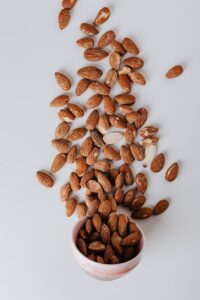 I ripped open the envelope and immediately started looking for the asterisks that tell you something isn’t normal. Index finger down the first page. Nothing. Index finger down the second page. Nothing. Index finger stopped at the top of the third page.
I ripped open the envelope and immediately started looking for the asterisks that tell you something isn’t normal. Index finger down the first page. Nothing. Index finger down the second page. Nothing. Index finger stopped at the top of the third page.
I gasped when I read, “Cholesterol * 310 mg/dL; Desirable level: below 200.”
That’s just not possible, I thought. That yucky stuff threatening my heart health. I don’t eat eggs, or mayonnaise, or a lot of butter or a lot of cheese, I reasoned. I’m constantly counting calories and watching my fat intake. Yes, I know smoking can make one’s cholesterol rise, but that alone can’t be the cause.
One week later, in late January, I sat in front of my family doctor as she looked over the report. She removed her reading glasses and looked me in the eye.
“This cholesterol count is not good,” she said in a calm, but authoritative voice. After querying me about my diet and my family medical history — my tiny mother had had issues with cholesterol — the doctor concluded that the high level of bad cholesterol, known as “LDL”, was probably due to my genes.
“In any event,” she said, “I’m afraid that you’re going to have to start taking something to bring the count down.”
“Statin?” I asked, knowing that my younger sister has been this sort of cholesterol-lowering drug for some years.
The doctor nodded affirmatively while typing out the prescription on her keyboard.
I left the doctor’s office, went across the street to the pharmacy, and got the prescription filled. That evening I opened the box of Lipitor and started reading the information disclosure, focusing on the side effects: diarrhea, liver function test abnormal, muscle pain, headache, and insomnia, to name a few of the most common reactions. I reluctantly popped the pill.
I woke the next morning to no apparent side effects, but with a stubborn curiosity to explore if there just might be another, natural way to solve my problem. I went to the search engine and typed in “Foods for lowering cholesterol.” It yielded 12 million results!!!
First up was an article from Harvard Health that started off with an encouraging statement: “Changing what foods you eat can lower your cholesterol.” The article then gave a brief explanation of how this could work:
Different foods lower cholesterol in various ways. Some deliver soluble fiber, which binds cholesterol and its precursors in the digestive system and drags them out of the body before they get into circulation. Some give you polyunsaturated fats, which directly lower LDL. And some contain plant [substances], which block the body from absorbing cholesterol.
The article listed ten types of foods that can contribute to reducing LDL included: oats, barley, beans, eggplant, nuts, vegetable oils, various fruits, soy, fatty fish, and food fortified with sterols and stanols. I’d never heard of sterols or stanols but found out that they are substances occurring naturally in small amounts in many grains, vegetables, fruits, legumes, nuts, and seeds and that manufacturers are now adding them to other foods, such as margarine, granola bars, and chocolate.
I skimmed various other articles and most of them confirmed what Harvard Health had printed, with oats repeatedly at the top of the list.
Oats contain a dietary fiber known as beta-glucan that slows digestion, suppresses the appetite, and increases satiety. Beta-glucan forms a viscous layer in the small intestine that lessens the intestinal uptake of dietary cholesterol and the body’s reabsorption of bile acids (which the body makes from cholesterol), with a greater elimination of those acids from the body.
When it comes to nuts, almonds and walnuts produce the most beneficial effects. Indeed, various studies over the past 30 years have indicated that eating a small amount of either regularly can have the effect of lowering LDL, while the consumption of walnuts does not lead to any significant differences in weight change.
None of this seemed overly complicated to me. I liked all of the foods on the list, and I was wishfully optimistic. I made a mental note of what I needed to get into the house and headed to the supermarket. I decided to give myself two months to test a new diet, and I set aside the Lipitor.
Over the ensuing eight weeks, I ate twenty grams of oat bran with a cup of yogurt for breakfast five or six times per week. I substituted white pasta and white bread with the whole-wheat versions. I replaced meat with legumes two or three nights per week. And pleasantly to my surprise, I discovered I could also add some of my other favorite foods, such as artichokes, avocados, raw beets, and fresh peas, as they are all high in fiber, a key ingredient for driving down LDL.
In the meantime, I continued my research, learning that around 90-95 percent of the U.S. population doesn’t consume the recommended daily quantity of fiber. And while millions of Americans are taking statins, many patients start them and then stop them several months later, once their cholesterol counts go down, only to see a subsequent rebound in LDL levels.
I also read about a relatively new pharmacological treatment to combat high cholesterol, PCSK9 inhibitors, which were approved by the U.S. Food and Drug Administration in 2015. The development of PCSK9 inhibitors was the response to a 2003 research project that found a genetic mutation causing some people to develop high levels of LDL and cardiovascular disease at an early age. Unlike statins, the new drug is taken by injection every two to four weeks, and there is some evidence that it has fewer side effects.
Exactly two months into the diet, on 25 March, it was Blood Draw (“BD”) Day. I waited overnight and returned to the clinic the next day to retrieve the results, admittedly with a bit of trepidation. I had my sights set on a 280 count, i.e. a ten percent reduction versus the 310 level in mid-January, and I’d decided that I’d surrender to the statins if I weren’t to have achieved my target. The receptionist printed out the report and without eyeing it, put it into an envelope that she sealed before handing it to me. I went outside and took a deep breath and slowly peeled away the adhesive closure. And there on the first line, it stated “Cholesterol * 254 mg/dL; Desirable level: below 200.” The asterisk was still there, but I’d achieved a reduction of approximately eighteen percent without medication and with simple, but satisfying, changes to my diet.
On a follow-up visit with the doctor, I admitted that I’d booted the statins, but she was quite pleased with the result and encouraged me to continue the diet as well as to start a new exercise routine, as physical activity can also make a contribution to lowering LDL. I’ll be getting on that once the gyms in Italy are re-opened later this spring.
https://www.health.harvard.edu/heart-health/11-foods-that-lower-cholesterol;
https://www.hsph.harvard.edu/nutritionsource/food-features/oats/
https://www.hsph.harvard.edu/nutritionsource/food-features/oats/https://pubmed.ncbi.nlm.nih.gov/8357360/
https://academic.oup.com/ajcn/article/108/1/174/5042152; https://www.verywellhealth.com/can-eating-walnuts-help-lower-your-cholesterol-698238
https://kitchenicious.com/best-nuts-for-lowering-cholesterol/
https://www.health.harvard.edu/blog/are-statins-enough-when-to-consider-pcsk9-inhibitors-2020060819986 “Our liver makes PCSK9 protein, and this protein breaks down LDL receptors, which remove LDL cholesterol from our bloodstream. So the more PCSK9 protein in our bodies, the fewer LDL receptors in our liver, and the higher our LDL cholesterol levels. PCSK9 inhibitors are monoclonal antibodies that block the PCSK9 protein from working. As a result, levels of LDL receptors increase, and LDL cholesterol levels fall. PCSK9 inhibitors work via a pathway different from statin medications, and may be used together.”

